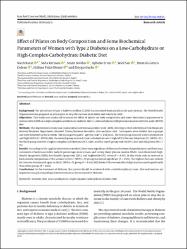Effect of Pilates on Body Composition and Some Biochemical Parameters of Women with Type 2 Diabetes on a Low-Carbohydrate or High-Complex-Carbohydrate Diabetic Diet

Göster/
Erişim
info:eu-repo/semantics/openAccessTarih
2022Yazar
Batar, NazlıKermen, Seda
Sevdin, Sezen
Ersin, Aybüke
San, Sevil
Erdem, Mustafa Genco
Pulat Demir, Halime
Güçlü, Duygu
Üst veri
Tüm öğe kaydını gösterKünye
Batar, N., Kermen, S., Sevdin, S., Ersin, A., San, S., Genco Erdem, M., Pulat Demir, H., & Guclu, D. (2020). Effect of Pilates on Body Composition and Some Biochemical Parameters of Women with Type 2 Diabetes on a Low-Carbohydrate or High-Complex-Carbohydrate Diabetic Diet. Iranian Red Crescent Medical Journal, 22(6).Özet
Arka plan: Tip 2 diyabetin (T2DM) prevalansı son 30 yılda çarpıcı biçimde arttı. Dünya Sağlık Örgütü, 2025 yılına kadar diyabet ve obezite artışını durdurmak için bir eylem planı hazırladı. Amaçlar: Bu çalışma, pilatesin yüksek kompleks karbonhidrat içeren T2DM'li kadınlarda vücut kompozisyonu ve bazı biyokimyasal parametreler üzerindeki etkisini değerlendirmek amacıyla yapıldı. diyabetik diyet veya düşük karbonhidratlı/yüksek tekli doymamış yağ asitleri (MUFA) diyeti. Yöntemler: Bu deneysel çalışma, Aralık 2018 ile Haziran 2019 tarihleri arasında Fatih Medical Park Hastanesi Dahiliye Bölümü'ne başvuran 120 T2DM'li kadın hasta üzerinde gerçekleştirildi. Katılımcılar 4 gruba ayrıldı ve 12 hafta boyunca takip edildi. Ortalama katılımcıların yaşı 41,67 +/- 3,83 idi. Birinci grup düşük karbonhidratlı ve yüksek MUFA (LC, MUFA) diyeti aldı, ikinci grup düşük karbonhidratlı ve yüksek MUFA diyeti aldı ve pilates yaptı (LC, MUFA + PL), üçüncü grup daha yüksek kompleks aldı karbonhidrat (HCC) diyeti, dördüncü grup ise HCC diyeti alıp pilates (HCC+PL) yaptı. Bulgular: Uygulanan müdahale yöntemine göre vücut kitle indeksi, vücut yağ yüzdesi, kas kütlesi, açlık kan şekeri, insülin, HbA1c, toplam kolesterol, yüksek yoğunluklu lipoprotein (HDL), düşük yoğunluklu lipoprotein (LDL) ve trigliserit (TG) değerleri (P < 0.05). Bu çalışmada sadece LC, MUFA+PL grubundaki kadınların vücut kas kompozisyonundaki artış anlamlı bulunmuştur (P<0.05). Vücut yağ oranındaki en yüksek düşüş yine LC, MUFA+PL grubunda belirlendi (P<0.05). Pilates yapan kadınların HDL düzeyleri diğer gruplara göre anlamlı düzeyde arttı (P<0.05). Sonuç: Diyabet tedavisinde hastanın multidisipliner bir ekiple değerlendirilmesi gerekmektedir. Diyet ve egzersiz diyabet tedavisinde önemli, farmakolojik olmayan müdahalelerdir. Background: The prevalence of type 2 diabetes mellitus (T2DM) has increased dramatically in the past 30 years. The World Health Organization has prepared an action plan to stop the increase in diabetes and obesity by 2025. Objectives: This study was conducted to assess the effect of pilates on body composition and some biochemical parameters in women with T2DM on a high-complex-carbohydrate diabetic diet or a low-carbohydrate/high-monounsaturated fatty acids (MUFA) diet. Methods: This experimental study was conducted on 120 woman patients with T2DM, referring to the Fatih Medical Park Hospital's Internal Medicine Department, Istanbul, Turkey, between December 2018 and June 2019. Participants were divided into 4 groups and were followed up for 12 weeks. The mean participants' age was 41.67 +/- 3.83 years. The first group received a low-carbohydrate and high MUFA (LC, MUFA) diet, the second group received a low-carbohydrate and a high-MUFA diet and did pilates (LC, MUFA + PL), the third group received a higher complex carbohydrate (HCC) diet, and the fourth group took the HCC diet and did pilates (HCC + PL). Results: According to the applied intervention method, there were significant differences between the preliminary and final measurements of bodymass index, body fat percentage, muscle mass, and fasting blood glucose, insulin, HbA1c, total cholesterol, high-density lipoprotein (HDL), low-density lipoprotein (LDL), and triglyceride (TG) values (P < 0.05). In this study, only an increase in body muscle composition of the women in the LC, MUFA + PL group was found significant (P < 0.05). The highest decrease in body fat ratio was determined again in the LC, MUFA + PL group (P < 0.05). HDLlevels of the women who did pilates increased significantly than other groups (P < 0.05). Conclusions: In the treatment of diabetes, the patient should be evaluated with a multidisciplinary team. Diet and exercise are important non-pharmacological interventions in the treatment of diabetes.
















